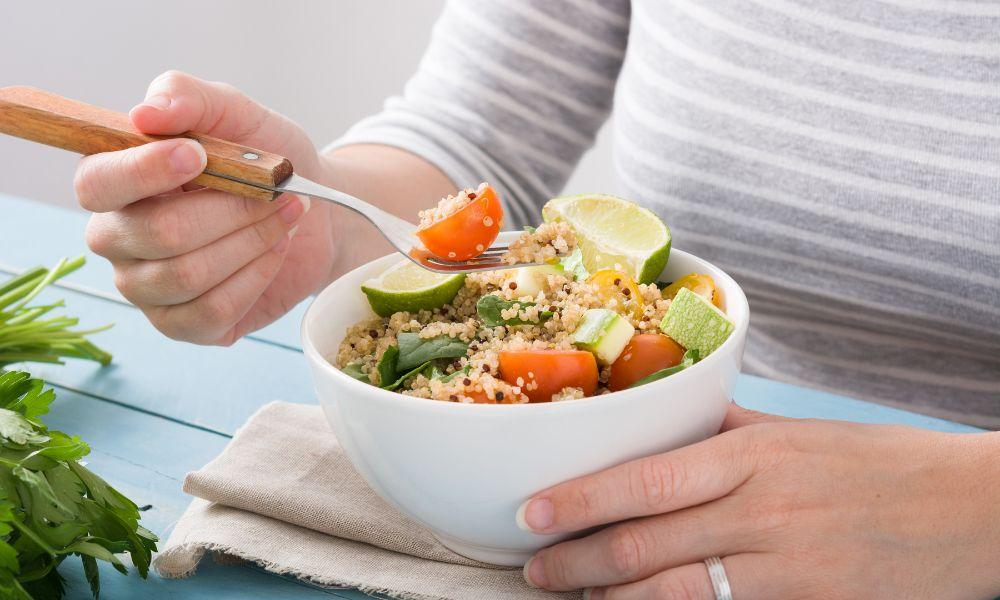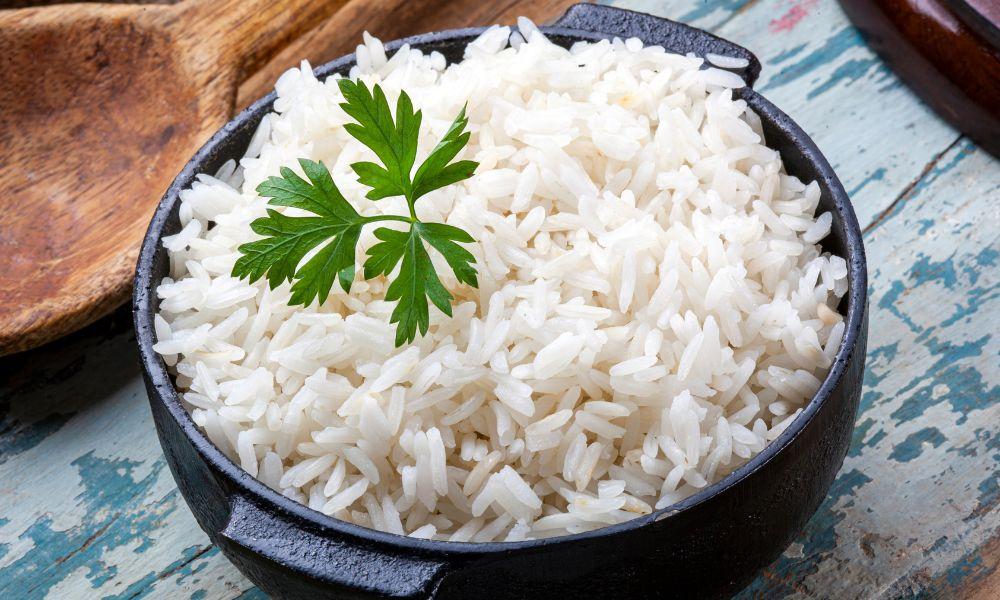Struggling with how to stop eating too much rice? This guide offers easy strategies and tasty alternatives to help you control your rice intake. Whether you aim to lose weight, manage blood sugar, or enhance your diet, you’ll find practical tips for a smooth transition.
[su_box title=”Summary of Key Points” style=”default” box_color=”#1383C8″ title_color=”#FFFFFF” radius=”3″]Want to eat less rice? Start by reducing it to less than 1 cup per meal. Consider alternatives like cauliflower rice or quinoa. The goal is to decrease carb cravings and make healthier choices easier over time. Remember, rice doesn’t have to be in every meal.[/su_box]

Controlling Rice Portions and Cravings🍚
Many Filipinos find it difficult to cut down on rice, as it has been a staple in their diets for generations. However, reducing carbohydrate consumption supports weight loss and helps prevent chronic diseases such as diabetes and heart disease.
💁♀️Tip: If quitting rice cold turkey seems too challenging, gradual reduction can be more sustainable. Start by cutting to less than 1 cup per meal, or skip rice at breakfast and have a maximum of 2 cups for the entire day. Over time, aim for smaller amounts, like 1/2 cup per meal, or eliminate it altogether.
Let’s take the example of Maria, a rice lover who wants to control her portions and reduce cravings. She cuts her rice intake in half, having only 1/2 cup per meal instead of a full cup. At first, she finds it challenging, but she reminds herself of the long-term benefits and stays committed.
Healthy Alternatives 🌿: To curb cravings and satisfy your meals without relying heavily on rice, explore healthy alternatives without feeling deprived. Vegetables with neutral taste can be excellent substitutes, such as green leafy vegetables (spinach, kale), squash, sayote (chayote), eggplant, green papaya, and mushrooms. These vegetables can be cooked in various ways and seasoned to add flavor to your meals.
Now that we’ve explored controlling rice portions and cravings let’s delve into the importance of nutrition awareness and calorie counting when managing your rice intake effectively.
Nutrition Awareness and Calorie Counting📊
Awareness of the nutritional content of your foods is key to making healthier choices and managing your overall caloric intake. When it comes to rice, understanding its macronutrient composition is essential.
📌 Fact: A typical cup of cooked white rice contains about 200 calories and 45 grams of carbohydrates, predominantly in the form of starch.
By tracking your meals and keeping a food diary, you can better understand calorie and carbohydrate content.
📝 Tip: This practice helps you make informed decisions about portion sizes and choose alternatives that are lower in calories but still nutritionally balanced.
Let’s consider the case of John, who wants to be more conscious of his rice consumption. He starts by meticulously tracking his meals using a mobile app or journal where he records the types and quantities of food he eats.
🌟 Outcome: With this knowledge, John is motivated to explore healthier options and finds that substituting some rice with vegetables or whole grains allows him to enjoy satisfying meals without compromising taste or nutritional value.
While calorie counting can be helpful, it’s important to remember that every individual’s nutritional needs vary based on age, gender, activity level, and overall health goals.
👩⚕️ Note: Consulting with a registered dietitian can provide personalized guidance on the appropriate caloric intake for your specific needs.
Having touched upon nutrition awareness and calorie counting, let’s explore meal preparation strategies that can assist in reducing rice consumption while still enjoying flavorful and satisfying dishes. 🍲📝
Key Studies and Facts 📚
🌾 A Harvard School of Public Health study revealed a significant link between greater white rice consumption and increased risk for type 2 diabetes. Those consuming 5 or more weekly servings had a 17% higher risk.
🍚 According to the International Journal of Obesity, reducing carbohydrate intake, such as from rice, could lead to more weight loss than low-fat diets—on average, about 7.8kg more in six months.
🇵🇭 The World Health Organization estimates that over half of the Filipino population consumes more carbohydrates than the recommended daily intake—mainly through rice, potentially causing obesity and other health risks.
Summary Tips for Reducing Rice Consumption 🍽️
🥗 Being aware of the nutritional content of the foods you consume is critical for making healthier choices and managing your overall caloric intake.
📖 Tracking your meals and keeping a food diary is an excellent practice to better understand calorie and carbohydrate content.
🥦 If you want to reduce your rice consumption, exploring healthier options like substituting some rice with vegetables or whole grains can be satisfying without compromising taste or nutritional value.
👩⚕️ Personalized guidance from a registered dietitian can help determine the right caloric intake for your specific needs.
Meal Preparation Strategies 🍱

Meal preparation is crucial for reducing rice consumption and adopting healthier eating habits. By planning your meals in advance, you can make conscious choices and have healthier alternatives readily available. Here are some effective meal preparation strategies to consider:
🔢 Step-by-Step Strategies 📝
- Batch Cooking: 🍲
- Dedicate a specific day or time of the week to prepare larger quantities of food that can be portioned and stored for later use. This helps save time and energy throughout the week.
- Portion Control: 🍚
- Invest in meal prep containers or reusable storage bags to portion out your meals ahead of time. This prevents overeating and makes sticking to your desired portion sizes easier.
- Variety is Key: 🥦🍗
- Incorporate diverse ingredients into your meals, such as lean proteins (chicken, fish, tofu), fiber-rich vegetables, and healthy fats (avocado, olive oil). Experiment with different flavors and spices to keep your meals interesting.
- Freeze Meals: ❄️
- Prepare extra portions of your favorite healthy dishes and freeze them for future consumption. This allows for convenient meals on busy days when cooking from scratch may not be feasible.
- Prep Ingredients: 🥒🥕
- Chop vegetables, marinate proteins, or pre-cook specific components of your meals in advance. This saves time during the cooking process and ensures that the right ingredients are readily available.
- Plan for Leftovers: 🍱
- Cook larger quantities intentionally so that you have leftovers for future meals. Use these leftovers creatively by incorporating them into salads, wraps, or stir-fries to prevent boredom with repetitive meals.
- Schedule and Flexibility: 📅
- Set aside dedicated time for meal preparation each week and allow flexibility in your plans. Life can get busy, so having backup options like pre-washed salad greens or frozen veggies can be convenient alternatives when time is limited.
Remember, meal preparation is an ongoing practice and will require trial and error to find the best strategies for you. Don’t be afraid to experiment with different methods and adjust as needed to fit your lifestyle and preferences. The goal is to create a sustainable routine that promotes healthy eating habits while reducing reliance on rice. 🌾
Now that we have covered meal preparation strategies let’s explore some delicious rice alternatives that can elevate the nutritional value of your meals without sacrificing taste or satisfaction. 🍽️
Rice Alternatives for Healthier Eating

While rice may be a staple in many Asian cuisines, numerous healthier alternatives offer similar textures and flavors without the carbohydrate load. Here are some rice alternatives worth considering:
🌟 Top Rice Alternatives 🌟
- Cauliflower Rice: 🍚
- Made by pulsing cauliflower florets in a food processor, this low-carb alternative provides a similar texture to rice and can be used in stir-fries, fried “rice,” or as a base for grain bowls.
- Quinoa: 🌾
- This protein-rich seed is packed with essential nutrients, making it an excellent substitute for rice. Cooked quinoa can be enjoyed as a side dish or mixed with vegetables and proteins for a complete meal.
- Broccoli Rice: 🥦
- Like cauliflower rice, broccoli rice is made by finely chopping or grating broccoli stems. It adds a nutritional boost to dishes like stir-fries and casseroles while keeping the carb content low.
- Shirataki Rice: 🍙
- Made from konjac yam, shirataki rice is extremely low in calories and carbohydrates. It has a gelatinous texture, but when cooked properly, it can mimic the softness of rice noodles.
- Mushroom Rice: 🍄
- Finely chopped mushrooms cooked with spices can provide a savory flavor reminiscent of traditional rice dishes. This option adds depth of flavor and extra nutrients to your meals.
- Vegetable Noodles: 🥕
- Spiralized vegetables such as zucchini, carrots, or sweet potatoes can be used instead of rice to create colorful and nutritious meals. These vegetable noodles can be lightly cooked or enjoyed raw for added crunch.
Imagine a hearty vegetable stir-fry with cauliflower rice or a flavorful quinoa salad with grilled chicken and fresh veggies – these alternatives not only reduce your carbohydrate intake but also provide additional vitamins, minerals, and fiber to support overall health.
By incorporating these rice alternatives into your meals, you can effortlessly reduce your rice consumption and explore new flavors and textures. Remember, there’s no one-size-fits-all approach, so feel free to experiment and find the options that satisfy your taste buds and nutritional needs.
Vegetable-Based Options 🥦
Vegetables are an excellent substitute for rice and offer a range of health benefits. Not only are they low in calories and rich in vitamins and minerals, but they also provide essential dietary fiber that can help you feel fuller for longer. 🌿 You can reduce rice consumption by incorporating vegetable-based options while enjoying flavorful and nutritious dishes.
🌟 Top Vegetable-Based Options 🌟
- Green Leafy Vegetables: 🌱
- Consider incorporating green leafy vegetables, such as spinach, kale, or bok choy, into your meals. These vegetables are packed with nutrients and have a neutral taste that pairs well with various flavors.
- Squash or Sayote (Chayote): 🎃
- For a heartier meal, vegetables like squash or sayote can be great alternatives to rice. They can be used as a base for curries, mixed into salads, or as a side dish.
- Eggplant: 🍆
- Another versatile vegetable option is eggplant. It has a slightly meaty texture when cooked and absorbs flavors well.
- Green Papaya: 🍈
- Popular in many Asian cuisines, green papaya is an excellent replacement for rice when grated and used in salads or added to soups and stews.
- Mushrooms: 🍄
- Mushrooms are another fantastic option to explore. They are versatile for different recipes and can be used as a filling for wraps or added to sautés.
By exploring these vegetable-based options, you can add variety to your meals while reducing your reliance on rice. 🌈 Experiment with different combinations and flavors to find the ones that suit your taste preferences and dietary needs.
Now that we’ve explored the vegetable-based options let’s dive into the world of grain variants and their benefits as alternative options to rice. 🌾
Habit Changes for Reduced Rice Consumption 🍚

Cutting down on rice consumption may seem challenging, especially if it has been a staple in your diet for a long time. However, with some habit changes and mindful choices, you can gradually reduce your rice intake and adopt a healthier meal approach. 🌱
- Gradual Reduction: A good starting point is gradually reducing your portion sizes. Instead of filling your entire plate with rice, aim for a smaller portion and fill the rest with protein and vegetables. You can start by cutting down to less than 1 cup of rice per meal or even skip rice at breakfast altogether. 🍽️
- Adaptation: Let’s say you typically consume three cups of rice per day. Try reducing it to two cups for the entire day, but increase your protein and vegetable intake to compensate for the decrease in carbohydrates. As you adapt to this change, continue lowering your rice portions until you reach a level that works best for you and aligns with your health goals. 🥦
- Healthy Alternatives: Exploring healthy alternatives to rice that can still satisfy a filling meal is also important. Vegetables such as green leafy vegetables, squash, sayote, eggplant, green papaya, and mushrooms can be great substitutes as they have a neutral taste and can easily replace the bulkiness of rice on your plate. 🥕
- Taste Adaptation: Remember, breaking the cycle of glucose dependency caused by high carbohydrate intake may take time. Don’t be discouraged if you experience carb cravings initially. As you reduce your rice consumption, you may find that your taste buds become more sensitive to sweetness, making dishes naturally sweeter without relying on excessive sugar. 🍭
Ensuring Balanced Diet Minus Excessive Rice 🍲
Reducing rice consumption doesn’t mean sacrificing a balanced diet. It’s crucial to ensure that you still meet your nutritional needs by incorporating diverse and nutrient-rich foods into your meals. 🍏
- Protein Focus: To achieve a well-rounded diet without excessive rice, consume ample protein, healthy fats, and various vegetables. Opt for lean sources like chicken, fish, tofu, beans, or lentils. These foods provide essential nutrients and contribute to a feeling of fullness and satiety. 🍗
- Balanced Plate: For example, instead of having a plate filled with rice, aim for a palm-sized portion of protein, a generous serving of mixed vegetables, and a small side dish of quinoa or other whole grains. This way, you still provide your body with the necessary carbohydrates while diversifying your nutrient intake. 🥦
- Healthy Fats: Don’t forget to incorporate healthy fats into your meals. Avocados, nuts, seeds, olive oil, and fatty fish like salmon provide essential fatty acids that support brain health and overall well-being. 🥑
- Listen to Your Body: Lastly, listen to your body and adjust your food intake accordingly. If you lead an active lifestyle or engage in activities like weightlifting that require higher carbohydrate intake, it’s important to strike a balance that suits your needs. 🏋️
Think of it as creating a colorful painting on your plate – each ingredient adds its own unique flavors and nutrients, resulting in a masterpiece for your health. 🎨
By focusing on these habit changes and ensuring a well-balanced diet minus excessive rice consumption, you can embark on a journey toward improved health and overall well-being. 🌟
